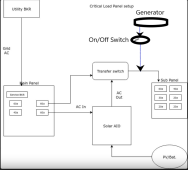Jeff From NJ
New Member
- Joined
- Dec 2, 2021
- Messages
- 68
I built a system around an MPPT Hybrid solar inverter I bought from China - 4KW 24VDC solar inverter with charger - pure sine wave, split phase output: 120V 240 AC 60Hz, and will be connecting the Inverter to a 30 Amp Chicago Electric EGS107501G2KIT manual transfer switch box that I have my generator connected to and a limited number of breakers to power important items in the house and would love a set of eyes to tell me if I need to change something before powering things up.
One of the photos attached shows the system as it stands, I will be connecting four 12V 100Ah LifePO4 batteries to the system, in series/parallel so I will get 24 V 100Ah power and will attach a 200 amp T Fuse anl with block to the + wire off the batteries before connecting the positive and negative wires to the inverter through the inverters battery input.
I currently have 6 Trina TSM-260PD05.08 (260W PV Module, MC4, PV Wire, 35mm Black Frame with White Backsheet, BOW, 60 Cell Poly, 15A Fuse, 1000VDC) solar panels that will connect to a 12-48 Volt Battery switch (solar disconnect) and then into the Inverter at the appropriate location. The plan is to wire the panels and connect the negative (-) of the solar panels to the disconnect, switch the disconnect OFF, and then wire the positive and negative panels into the inverter.
The last step, and my biggest question, is how to wire the grid power into the inverter so the box will properly control the power. I plan on having the house, via the manual disconnect generator box, attach to the inverter with the hope that I will power those items in the manual disconnect box first from solar panels, then from battery power, and then from the grid, or if it is down, from the generator which is directly connected to the manual disconnect box. My question is, I don't see an obvious place in the manual disconnect to jump to the solar inverter. If I connect the inverter to the grid, via the two Hots in my main house breaker box, then the inverter would operate properly except if the grid went down. After the panels stopped producing electricity and the batteries were drained, the generator, which is directly connected to the manual disconnect, would not send power to the inverter so the inverter, I believe, would never know the generator is operating (while the grid is down) and after my panels and batteries were exhausted, the inverter would not realize there is power available via the generator.
Is there a better way to hook this all up so the inverter, via the AC Input (Hot 1/Hot 2), could control everything? I'm sure there is a way but I am simply missing the obvious.
Thanks everyone!
One of the photos attached shows the system as it stands, I will be connecting four 12V 100Ah LifePO4 batteries to the system, in series/parallel so I will get 24 V 100Ah power and will attach a 200 amp T Fuse anl with block to the + wire off the batteries before connecting the positive and negative wires to the inverter through the inverters battery input.
I currently have 6 Trina TSM-260PD05.08 (260W PV Module, MC4, PV Wire, 35mm Black Frame with White Backsheet, BOW, 60 Cell Poly, 15A Fuse, 1000VDC) solar panels that will connect to a 12-48 Volt Battery switch (solar disconnect) and then into the Inverter at the appropriate location. The plan is to wire the panels and connect the negative (-) of the solar panels to the disconnect, switch the disconnect OFF, and then wire the positive and negative panels into the inverter.
The last step, and my biggest question, is how to wire the grid power into the inverter so the box will properly control the power. I plan on having the house, via the manual disconnect generator box, attach to the inverter with the hope that I will power those items in the manual disconnect box first from solar panels, then from battery power, and then from the grid, or if it is down, from the generator which is directly connected to the manual disconnect box. My question is, I don't see an obvious place in the manual disconnect to jump to the solar inverter. If I connect the inverter to the grid, via the two Hots in my main house breaker box, then the inverter would operate properly except if the grid went down. After the panels stopped producing electricity and the batteries were drained, the generator, which is directly connected to the manual disconnect, would not send power to the inverter so the inverter, I believe, would never know the generator is operating (while the grid is down) and after my panels and batteries were exhausted, the inverter would not realize there is power available via the generator.
Is there a better way to hook this all up so the inverter, via the AC Input (Hot 1/Hot 2), could control everything? I'm sure there is a way but I am simply missing the obvious.
Thanks everyone!









